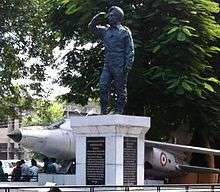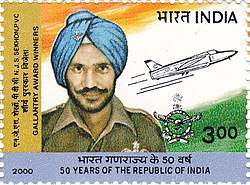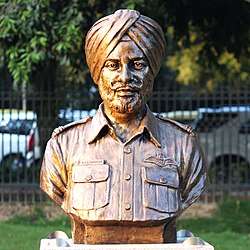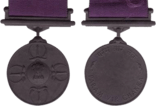Nirmal Jit Singh Sekhon
Flying Officer Nirmal Jit Singh Sekhon, PVC (17 July 1943 – 14 December 1971) was an officer of the Indian Air Force. He was posthumously awarded the Param Vir Chakra, India's highest military decoration during war time, in recognition of his lone defence of Srinagar Air Base against a PAF air raid during the Indo-Pakistani War of 1971.[2] He is the only member of the Indian Air Force to be honoured with the PVC.[3]

Flying Officer Nirmal Jit Singh Sekhon | |
|---|---|
 | |
| Born | 17 July 1943 Ludhiana,[1] British India (now in Punjab, India) |
| Died | 14 December 1971 (aged 28) Srinagar, Jammu and Kashmir, India |
| Allegiance | |
| Service/ | |
| Years of service | 1967–1971 |
| Rank | |
| Unit | No. 18 Squadron |
| Battles/wars | Indo-Pakistani War of 1971 |
| Awards | |
Early life
Nirmal Jit Singh Sekhon was born on 17 July 1943[4] in the village of Isewal, Ludhiana, Punjab Province, British India.[1] He was the son of M.W.O. (Honorary) Flight Lieutenant Tarlok Singh Sekhon.[5] He was commissioned into the Indian Air Force on 4 June 1967 as a Pilot Officer.
Param Vir Chakra Award
During the Indo-Pakistani War of 1971, he was serving with the No.18 Squadron, "The Flying Bullets" of IAF, flying the Folland Gnat fighter aircraft based at Srinagar. On 14 December 1971, Srinagar airfield was attacked by six Pakistan Air Force F-86 jets of 26 Sqn from PAF base Peshawar. Flying Officer Sekhon was on readiness duty at that time. As soon as the first aircraft attacked, Sekhon rolled for take-off as No 2 in a two-Gnat formation, with Flt Lt Ghumman in lead, just as the first bombs were falling on the runway. Only delayed due to dust kicked up by the preceding Gnat, Sekhon lost no time in singling out the first Sabre pair, which was re-forming after the bombing run. The Gnat Leader, Flt Lt Ghuman, lost visual with his wingman just after take-off, remained out of the fight leaving Sekhon to handle the muddle all by himself. In the ensuing air battle, Sekhon scored a direct hit on one Sabre[6] and set another ablaze. The latter was seen heading away towards Rajauri, trailing smoke.[6]
Sekhon, after being hit, was advised to return to the base. He is said to have flown in straight, wings level for some time, then going inverted, plummeting down, probably due failure of control system. He attempted a last-minute ejection, which did not prove successful, as his canopy was seen to fly off. The wreckage of the Gnat was found in a gorge, near the road coming from Srinagar town to the base, a few miles from the base. Despite many search efforts by Army and Air Force, his remains were never found due to the mountainous terrain of where his fighter went down, much to the disappointment of his wife and family.
A detailed story of his effort has been mentioned in fairly detailed account by Air Cdre Kaiser Tufail.[7] His skill was later also praised in an article by Salim Baig Mirza, the pilot who shot him down.[8] The bravery, flying skill and determination displayed by Flying Officer Sekhon, against odds of 1:6, earned him India's highest wartime medal for gallantry, the Param Vir Chakra.
Citation
The Param Vir Chakra citation reads as follows:
CITATION
FG OFFR NIRMAL JIT SINGH SEKHON
18 SQUADRON 10877 F(P)Flying Officer Nirmal Jit Singh Sekhon was a pilot of a Gnat detachment based at Srinagar for the air defence of the valley against Pakistani air attacks. From the very outbreak of the hostilities he and his colleagues fought successive waves of intruding Pakistani aircraft with valour and determination, maintaining the high reputation of the Gnat aircraft. On 14 December 1971, Srinagar airfield was attacked by a wave of enemy Sabre aircraft. Flying Officer Sekhon was on readiness duty at the time. Immediately, however, no fewer than six enemy aircraft were overhead, and they began bombing and strafing the airfield. In spite of the mortal danger of attempting to take off during the attack, Flying Officer Sekhon took off and immediately engaged a pair of the attacking Sabres. In the fight that ensued, he secured hits on one aircraft and damaged another. By this time the other Sabre aircraft came to the aid of their hard-pressed companions and Flying Officer Sekhon's Gnat was again outnumbered, this time by four to one.
Even though alone, Flying Officer Sekhon engaged the enemy in an unequal combat. In the fight that followed, at treetop height, he almost held his own, but was eventually overcome by the sheer weight of numbers. His aircraft was shot down by a gunfire of one of the Sabres and he was killed.
The sublime heroism, supreme gallantry, flying skill and determination above and beyond the call of duty displayed by Flying Officer Sekhon in the face of certain death have set new heights in Air Force traditions.[6]
Honours
Nirmal Jit Singh Sekhon is remembered for his gallantry and statues of him have also been erected in many cities in Punjab.
A marine tanker built in 1985 was named Flying Officer Nirmal Jit Singh Sekhon, PVC.
Legacy and depictions in popular culture

A statue in tribute of Nirmal Jit Singh Sekhon was erected at the district court of Ludhiana (first erected at Samrala Chowk, Ludhiana) in the courtyard next to the flag pole. A decommissioned Folland Gnat fighter is part of the memorial and serves as a gate guardian.
His statue along with a decommissioned Folland Gnat fighter has been placed in the Indian Air Force Museum, Palam.
References
- Vasdev, Kanchan (30 January 2003). "Sekhon's hamlet to be 'adarsh village'". The Tribune (Chandigarh). Archived from the original on 1 March 2004. Retrieved 11 April 2016.
- "Batchmates remember of IAF's lone Param Vir Chakra awardee recall his valour". The Indian Express. 5 June 2017. Retrieved 11 June 2020.
- "IAF scales 3 virgin peaks in Ladakh region". Hindustan Times. 27 July 2012. Archived from the original on 13 March 2014. Retrieved 27 July 2012.
- "Param Vir Chakra winners since 1950". The Times of India. Indiatimes News Network. 25 January 2008. Archived from the original on 18 October 2016. Retrieved 14 November 2016.
- "The Tribune, Chandigarh, India – Ludhiana Stories". Tribuneindia.com. Retrieved 27 July 2012.
- Param Vir Chakra (PVC) Awardee: Fg Offr Nirmaljit Singh Sekhon, PVC, The War Decorated India & Trust, retrieved 1 September 2014
- "A Hard Nut to Crack". kaiser-aeronaut.blogspot.com/. Retrieved 2 February 2014.
- Baig, Salim (September 2000). "Air Battles December 1971-My Experience". Defencejournal.com. Retrieved 27 July 2012.
External links
| Wikimedia Commons has media related to Nirmal Jit Singh Sekhon. |
- Flying Officer Nirmal Jit Singh Sekhon's citation of the Param Vir Chakra at Bharat-Rakshak.com.
- File Photo of Marine Tanker Flying Officer Nirmal Jit Singh Shekhon, PVC
- A tribute on Bharat-Rakshak
- A tribute to Nirmal Jit
- At Sikh History
- Profile of Sekhon on Tribune India
- Jai Hind Jai Bharat
- https://web.archive.org/web/20101103234927/http://shaheednjssekhon.com/
- Youtube Video by Headlines today which, at 13:31, shows animated account of Nirmal Jit Singh Sekhon's PVC Action.
